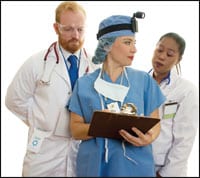 |
Businesses must embrace change in order to endure.
Within most businesses, one will find leaders, followers, innovators, implementers, and support staff—together, they constitute the Team, with a capital T.
Your practice is made up of yourself and your Team, which can include everyone in your business, from the boss to the intern.
On a scheduled basis, your team can (and, perhaps, should) undertake a self-assessment process in order to gauge its own effectiveness and, as a result, improve performance.
As a leader, you must clarify your practice’s goals and develop a sense of “co-ownership” among the team—even if members of your team may not be legal owners of your practice.
To fulfill this objective, you should familiarize yourself with an understanding of the “chi” of team building. Before you can assess your team (and yourself)—as well as look ahead to planning ways to improve performance and results—you should review a few basic tenets of envisioning, building, and maintaining the Team.
HARMONY
Managers point to harmony as the secret of Japan’s business success. When the entire staff embraces harmony, the result is unparalleled trust, cooperation, and loyalty. Productivity is increased, responsibility is shared, and employee relations are smoother.1
ARTICULATE YOUR MISSION
Harmony can start with a mission statement. I wasn’t a fan of mission statement exercises until I read one that I liked.
Take time to create or review an office mission statement. This only needs to be done once, and it should be posted for both patients and staff to see. It is a simple paragraph that will set the tone for all current and future employees as to the purpose of the practice.
This example of a mission statement was taken from the book Medical Practice Policies and Procedures:
“Our mission is to be the best medical office in the country. We are committed to being an enthusiastic team, excited about caring for our patients and promoting their lifelong health. Our patients’ emotional and physical well being is our highest priority. We will always treat our patients with the utmost respect and tact. We will be clear in our communications with them regarding their condition, treatment options, and finances. We will continue to enhance our own personal development through continuing education and team building to better serve the cause of quality medicine.”2
The following version of the above mission statement has been modified by me and should be read carefully:
“Our mission is to be one of the best medical offices in the country. We are committed to being an enthusiastic team, excited about caring for our community and promoting lifelong health to our patients. Our highest priority is that of our patients’ physical and emotional well being. We strive to treat our patients and each other with the utmost respect and tact. We will clearly communicate issues regarding medical conditions, treatment options, and finances. We will continue to enhance our own personal development through continuing medical education and team building to better serve the cause of quality medicine.”
Don’t assume that your employees would think a mission statement is only for hospitals and charity organizations. You will find that everyone will appreciate reading the practice’s goals in a simple paragraph.
Don’t spend weeks on this project, either. Create something that resonates with your office, and print it. Simplification is everything.
Reward all the employees yearly, every year. Having some type of team gathering at the end of the year or, perhaps, to begin each new year, is crucial for retention and morale.
Whether it’s a bowling party or a fancy dinner, recognize that you are a team and that everyone on the team is important.
Don’t cancel the reward. It is incredibly demoralizing to have the end-of-the-year bonus or party cancelled because profits are down. Be creative—your team will bond and grow during the ups and downs.
Improve the office energy. Look at your office colors and listen to the sounds filling the hallways. It is very important to create an environment that portrays calm, warm, and caring—yet professional.
The days of hospital white on grey have gone. Color and music therapy are here. Experiment with sounds and colors that your entire office and patients will respond to well.
COOPERATION
Automotive genius and inventor of the assembly line, Henry Ford, was quoted as saying, “Coming together is a beginning, keeping together is progress, and working together is success.”
Embrace and encourage collaboration. Our kindergarten teachers believe that cooperativeness is linked to greater learning, emotional maturity, and stronger personal identity.
As medical colleagues, we share knowledge and ideas that lead us to better decision-making and improved patient outcomes. Building trust within your team and becoming aware of everyone’s strengths is important. Incredible things can be accomplished when nobody cares about who gets the credit.
When it comes to staff meetings, I have had it both ways—too few meetings and too many meetings. I concluded that the correct number of meetings is somewhere in between the two.
Schedule a meeting only when necessary. I’m not a believer in weekly or even monthly meetings, but, without question, thinking that you can get by without ever having a staff meeting is not sensible.
Meetings need to be run well so as not to be disrespectful. Keep it simple, begin on time with an agenda, start with old business, move on to new business, and close the meeting on time with action items.
The meeting should never run over 1 hour. Notes from the meeting should then be put into a memo or e-mailed to the group to improve follow-through.
Good meetings are the best way to resolve issues, discuss new ideas, and encourage teamwork.
JOB DESCRIPTIONS
If you don’t have a job description, then how are you supposed to do your job? Sure, the title of receptionist is self-explanatory; however, the last receptionist also filed charts, took out the trash, called patients who didn’t show, and set the tone for the entire office.
Whether you are adding an assistant, nurse, or cleaning crew, it’s only fair to inform them of your expectations in advance and in writing.
Don’t assume that the other receptionists or staff has adequately trained the “new girl.” As the childhood game of telephone taught us, the information filtered down is never as clear as the original.
Present any new employee with a copy of their job description. I learn best by being told what’s expected of me. Usually, if you teach someone how to do something one time, it saves them from trying to learn it on their own, several times.
SYNCHRONIZED EFFORT
Ever watch a team of professional cyclists? A powerful and streamlined collective. Within each member lies a desire to help the group move forward. The team takes turns leading and, because of this, there is an understanding and respect for the current leader.
Invest in uniforms. Uniforms have been used by countless organizations with resounding success. Select a comfortable and professional-looking uniform to match your specialty. Many offices supply these to the staff at no charge; others will ask the staff to purchase their own.
Uniforms can improve office dynamics by leaps and bounds almost immediately.
Have a policies and procedures manual. In a well-run practice, the personnel have clearly defined roles and responsibilities.
Having one set of basic rules that everyone is familiar with and understands will promote a cohesive team who is comfortable with their roles.
|
See also “The 21st Century Medical Practice” by Catherine Maley, MDBA, in the September 2006 issue of PSP. |
Imagine playing a game for which no one knew the rules. It wouldn’t take long for individuals in the group to make up rules that may not benefit everyone. Having a clearly written book of office rules and policies that has been read by everyone is paramount for success.
Don’t rely on an old and outdated Policies & Procedures (P&P) manual that is hidden away in a drawer somewhere. The P&P manual needs to be visible to everyone.
Don’t be too stubborn or busy to make changes if needed.
A P&P manual is the evolution of your practice and needs to reflect that growth. Keep things simple; and please don’t have a lawyer write your P&P manual.
Lead by example. Do your part the very best that you possibly can. This will inspire others to do the same.
Christopher J. Stacey is a nationally certified physician assistant with a master’s degree in medical science. He works with facial plastic surgeon R. Emil Hecht, MD, in Bellingham, Wash, and works in emergency medicine in Taos, NM, with Lesa Fraker, MD. He can be reached by e-mail at .
REFERENCES
- Benzberger C. Japan Business: The Portable Encyclopedia for Doing Business with Japan. San Rafael, Calif: World Trade Press; 1994:155.
- Moghadas KI. Medical Practice Policies and Procedures. Chicago: American Medical Association; 2005:13.





